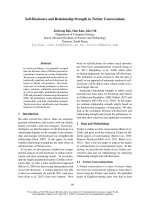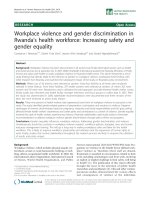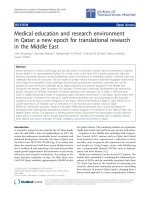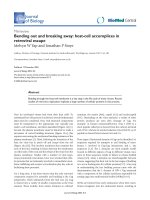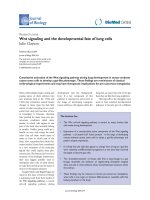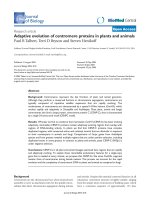Báo cáo sinh học: " Larval competition and genetic diversity in Tribolium castaneum" pot
Bạn đang xem bản rút gọn của tài liệu. Xem và tải ngay bản đầy đủ của tài liệu tại đây (718.15 KB, 10 trang )
Original
article
Larval
competition
and
genetic
diversity
in
Tribolium
castaneum
C
García
MA
Toro
2
1
Facultad
de
Biologia,
Area
de
Genetica,
Departamento
de
Biologia
Fundamental,
Santiago
de
Compostela,
Galicia;
2
CIT-INIA,
Departamento
de
Produccidn
Animal,
Carretem
de
la
Coruna,
Madrid,
Spain
(Received
9
March
1992;
accepted
24
November
1992)
Summary -
The
study
of
the
relationship
between
genetic
homogenity
and
intensity
of
competition
in
groups
of
organisms
may
help
to
explain
the
widespread
existence
of
sexual
reproduction
and
it
can
also
be
used
to
design
efficient
crop
mixtures.
To
study
this,
we
compared
the
survival
of
sib
groups
and
random
groups
of
larvae
of
the
beetle
Triboliunre
castaneum
maintained
at
high
population
density:
every
group
was
formed
by
introducing
150
eggs
in
1
g
of
culture
medium.
The
larvae
in
every
group
were
counted
weekly.
The
random
groups
survived
longer,
as
they
had
more
larvae
in
the
last
weeks.
This
advantage
was
related
to
a
higher
early
mortality,
which
reduced
competition
in
the
long
run
in
these
groups.
Therefore,
in
the
early
stages
of
development,
our
results
did
not
confirm
the
hypothesis
that
genetically
heterogeneous
groups
reduce
competition
through
diversification
in
the
use
of environmental
resources.
In
addition,
a
clear
increase
in
between-group
variability
for
survival
was
found
in
the
sib
groups, implying
the
presence
of
genetic
variance
for
competitive
ability
at
constant
initial
densities
in
this
species.
genetic
homogeneity
/
elbow-room
model / genetic
variance
for
competition
/
lb
ibolium
castaneum
.
Résumé -
Compétition
larvaire
et
diversité
génétique
chez
Tribolium
castaneum.
L’étude
de
la
relation
entre
l’homogénéité
génétique
et
l’intensité
de
la
compétition
au
sein
de
groupes
d’organismes
peut
servir
à
expliquer
la
prédominance
de
la
reproduction
sexuée
dans
la
nature,
et
elle
pourrait
aussi
être
utilisée
pour
mettre
au
point
des
mélanges
de
cultures.
Dans
ce
but,
on
a
comparé
la
viabilité
en
haute
densité
de
populations
de
larves
de
Tribolium
castaneum
maintenues
en
groupes
de
frères
ou
bien
en
groupes
aléatoires.
Chaque
groupe
était
établi
en
introduisant
150
oeufs
sur 1
g de
milieu
de
culture.
Les
larves
de
chaque
groupe
étaient
comptées
chaque
semaine.
Les
groupes
aléatoires
ont
survécu
plus
de
temps,
mais
cet
avantage
était
associé
à
une
plus
haute
mortalité
initiale,
ce
qui
a
réduit
*
Correspondence
and
reprints
la
compétition
à
long
terme
dans
ces
groupes.
En
conséquence,
dans
les
premiers
stades
de
développement,
on
n’a
pas
confirmé
l’hypothèse
selon
laquelle
des
groupes
génétiquement
hétérogènes
pourraient
subir
une
moindre
compétition
par
une
utilisation
plus
diversifiée
de
l’environnement.
On
a
observé
que
la
variabilité
pour
la
viabilité
était
plus
grande
entre
les
groupes
de frères,
ce
qui
indique
l’existence
d’une
variance
génétique
pour
l’aptitude
à
survivre
à
la
compétition
dans
cette
espèce.
homogénéité
génétique
/
modèle
elbow-room
/
variance
génétique
pour
la
compétition
/
Tribolium
castaneum
INTRODUCTION
The
study
of
the
relationship
between
genetic
homogeneity
and
intensity
of
com-
petition
within
a
group
of
individuals
has
both
theoretical
and
practical
interest
in
modern
biology
(Bell,
1985).
Firstly,
the
subject
is
related
to
the
evolution
and
maintenance
of
sexual
reproduction.
It
has
been
claimed
that
sexually
reproducing
parents
could
be
at
an
advantage
over
asexually
reproducing
ones
because
their
off-
spring
are
genetically
more
variable
(Williams
and
Mitton,
1973;
Maynard
Smith,
1976).
If
this
increase
in
genetic
variation
results
in
lower
competition
between
sibs
and
smaller
offspring
mortality,
sexual
parents
could
have
a
greater
fitness.
This
is
the
&dquo;elbow-room&dquo;
model
of
sib
competition
(Young,
1981),
based
on
the
assumption
that
individuals
with
less
similar
genotypes
have
less
similar
ecologi-
cal
requirements.
Some
empirical
tests
of
the
model
have
been
made
using
different
plant
and
animal
species,
and
the
results
were
very
diverse,
the
relationship
between
genetic
homogeneity
and
the
intensity
of
competition
being
positive
in
some
cases
(Perez-Tome
and
Toro,
1982;
Ellstrand
and
Antonovics,
1985;
Kelley
et
al,
1988;
Martin
et
al,
1988)
and
negative
in
others
(Jasienski,
1988;
Jasienski
et
al,
1988).
In
addition,
no
relationship
was
found
in
some
experiments
(Fowler
and
Partridge,
1986;
Willson
et
al,
1987;
Kelley,
1989;
Tonsor,
1989).
Secondly,
the
topic
has
a
bearing
on
the
agronomic
advantage
of
mixed
crops
over
monocultures
(Valentine,
1982;
Spitters,
1983).
Mixed
crops
may
outyield
monocultures
because
different
strains
or
varieties
complement
each
other
in
their
canopies,
root
systems,
or
nu-
tritional
requirements
(Trenbath,
1974).
Mixtures
may
also
have
greater
resistance
to
diseases
(Wolfe
and
Barret,
1980).
Thus,
a
better
understanding
of
the
nature
of
the
relationship
between
genetic
homogeneity
and
competition
would
make
the
result
of
crop
mixture
more
predictable
and,
therefore,
its
use
will
be
more
efficient
(Bell,
1985).
We
carried
out
an
experiment
on
sib
competition
using
the
beetle
TW
6o/!
Mm
castaneum
to
analyse
in
detail
possible
differences
in
the
competition
process
be-
tween
similar
and
non-similar
genotypes.
Triboliu!z
castaneum
is
a
useful
organism
to
model
these
situations,
because
its
population
size
is
regulated
to
a
great
extent
by
competition.
Moreover,
there
is
an
ample
bibliography
on
competition
in
this
species
(Park
et
al,
1964;
King
and
Dawson,
1972;
Mertz,
1972).
We
used
a
very
high
population
density
to
ensure
strong
competition.
By
doing
so,
we
expected
to
increase
the
probability
of
detecting
differences
in
competition
between
our
experimental
groups.
This
strategy
has
the
additional
advantage
of
simplifying
the
analysis
of
the
competition
process.
Competition
is
complex
in
Tribolium,
because
it
is
dependent
on
many
mechanisms
involving
different
life
stages,
such
as
eggs,
larvae,
pupae
or
adults.
However,
pupation
is
inhibited
at
high
population
densities
(Botella
and
Mensua,
1986),
such
that
no
pupae
or
adults
develop.
Thus,
only
mechanisms
involving
competition
among
eggs
and
larvae
need
to
be
taken
into
account
when
interpreting
the
experimental
results.
MATERIALS
AND
METHODS
Beetles
were
randomly
sampled
7
d
after
their
adult
emergence
from
the
Consejo
laboratory
population.
All
individuals
were
maintained
at
30°C
and
60%
relative
humidity.
Culture
medium
consisted
of
95%
whole
wheat
flour
and
5%
dried
brewer’s
yeast.
Two
random
samples
of
parents
were
used.
Each
sample
consisted
of
25
males,
each
male
being
mated
to
20
virgin
females
during
8
days.
To
increase
egg
harvest,
each
female
was
subsequently
transferred
to
a
separate
3
x
3.5
cm
glass
vial
with
2
g
culture
medium
which
was
sifted
24
h
later
to
recover
the
eggs.
These
eggs
were
used
to
set
up
competition
vials
(3
x
3.5
cm
glass
vials
with
a
plastic
cap
and
1
g
of culture
medium).
As
we
expected
to
have
high
population
densities
in
the
vials,
we
made
a
hole
of !
6
mm
in
diameter
in
the
caps,
and
covered
it
with
a
fine
wire
mesh
to
improve
ventilation
and
to
prevent
an
excessive
accumulation
of
humidity.
There
were
2
experimental
treatments.
In
the
first,
a
random
sample
of
150
eggs
fertilized
by
a
single
male
parent
were
put
together
in
a
competition
vial.
Thus,
genetically
homogeneous
groups
were
obtained,
individuals
sharing
the
same
vial
being
related
at
least
as
half-sibs.
In
the
second,
eggs
sired
by
all
males
were
pooled,
random
samples
of
150
being
taken
from
the
pool
and
introduced
into
competition
vials.
These
gave
rise
to
genetically
heteregeneous
groups.
Setting
up
competition
vials
took
4
d.
From
the
first
sample
of
parents,
25
homogeneous
groups
were
obtained
on
the
1st
and
25
heterogeneous
groups
on
the
third.
Likewise,
25
heterogeneous
groups
and
25
homogeneous
groups
were
obtained
from
the
second
sample
of
parents
on
the
second
and
fourth
d,
respectively.
Thus,
the
same
parents
provided
the
eggs
for
the
homogeneous
and
heterogeneous
groups.
In
what
follows,
the
set
of
competition
vials
corresponding
to
the
first
sample
of
parents
will
be
called
repetition
A,
and
that
corresponding
to
the
second
sample
of
parents
will
be
called
repetition
B.
Homogeneous
competition
vials
started
from
<
150
eggs
were
discarded.
Thus,
only
data
from
34
homogeneous
and
49
heterogenous
competition
vials
were
analysed.
The
numbers
of
larvae,
pupae
and
adults
per
competition
vial
were
counted
2
wk
after
the
vials
were
established.
Larvae,
pupae
and
culture
medium
were
returned
to
the
vial,
and
the
adults
were
removed.
These
counts
were
repeated
weekly,
as
long
as
living
animals
were
found
in
the
vials.
The
culture
medium
was
not
changed.
To
analyse
the
survival
of
the
individuals
in
the
homogeneous
and
heterogeneous
groups,
we
carried
out
a
log
rank
test
for
the
comparison
of
the
survival
in
2
samples,
as
described
in
Cox
and
Oakes
(1984),
chapter
7.
This
method
considers
that
the
survival
function
takes
a
log-linear
form.
The
test
involves
the
calculation
of
the
first
and
second
derivatives
of
the
log
likelihood
survival
function,
which,
for
the
null
hypothesis
of
no
difference
in
survival
between
the
2
groups,
are:
Where
dj
=
do;
+
di
;,
do;
and
d
ij
being
the
number
of
individuals
dying
from
time j
to
time j
+
1
in
the
homogeneous
and
heterogeneous
groups,
respectively,
and
rj
=
r
oj
+
rl!,
r
oj
and
rl!
being
the
number
of
individuals
alive
at
time j
in
the
homogeneous
and
heterogeneous
groups.
The
statistic
W!
=
U2/I
has,
under
the
null
hypothesis,
approximately
a
X2
distribution
with
1
degree
of
freedom.
This
test
can
also
be
obtained
formally
by
setting
up
a
separate
2 x
2 contingency
table
for
every
time
j,
with
rows
corresponding
to
the
kind
of
group
and
columns
to
survival,
and
carrying
out
the
combined
test
for
association
according
to
the
method
of
Mantel
and
Haenszel
(Cox
and
Oakes,
1984).
The
second
week
counts
for
the
homogeneous
groups
of
repetition
B
were
missing.
For
this
reason,
we
eliminated
that
week
from
the
analyses.
Also
for
this
reason,
in
the
calculation
of
the
correlation
between
the
initial
and
the
final
densities
in
the
vials,
we
estimated
the
initial
density
as
the
mean
number
of
larvae
in
wk
1
and
3.
Final
density
was
estimated
as
the
mean
number
of
larvae
found
in
counts
9
and
10.
Later
counts
were
not
considered
because
larval
numbers
were
too
low
and
many
vials
were
empty.
RESULTS
As
intended,
the
competition
intensity
attained
in
the
vials
was
very
high.
Only
16
of
the
5 100
eggs
used
in
the
homogeneous
groups
became
adults,
while
6
adults
emerged
from
7
350
eggs
in
the
heterogeneous
groups.
As
the
number
of
pupae
found
was
also
very
low,
only
larvae
number
was
analyzed.
In
table
I,
it
can
be
seen
that
the
number
of
larvae
surviving
in
the
last
weeks
was
greater
in
the
heterogeneous
groups
in
both
repetitions.
A
log
rank
test
to
compare
the
larval
survivals
in
the
2
kinds
of
groups
failed
to
find
significant
differences
in
repetition
A,
but
found
them
in
repetition
B.
When
the
data
of
both
repetitions
were
pooled,
the
log
rank
test
detected
a
significant
advantage
in
survival
for
the
heterogeneous
groups
(table
II).
Thus,
the
heterogeneous
groups
survived
longer
than
the
homogeneous
groups.
However,
in
the
first
weeks,
the
homogeneous
groups
tended
to
have
a
higher
survival
than
the
heterogeneous
groups,
but
tended
also
to
have
a
lower
survival
in
the
last
weeks
(fig
1).
A X2
test
of
contingency
for
the
number
of
individuals
alive
and
dead
in
each
kind
of
group
found
these
differences
in
survival
as
significant
in
some
weeks
(table
I).
However,
the
X2
tests
in
the
same
repetition
were
not
independent,
as
they
corresponded
to
the
same
vials.
In
fact,
those
vials
having
higher
initial
numbers
of
larvae
in
the
first
weeks
tended
to
be
among
those
with
fewer
larvae
in
the
last
weeks.
In
repetition
A,
the
correlation
between
initial
and
final
larval
densities
was
-0.49
(n
=
23,
P
<
0.05)
in
the
homogeneous
groups
and
-0.33
(n
=
25,
NS)
in
the
heterogeneous
groups.
In
repetition
B,
these
correlations
were
-0.50
(n
=
11,
NS)
and
-0.12
(n
=
24,
NS).
When
data
were
pooled
across
repetitions,
correlations
of
-0.48
(n
=
34,
P
<
0.005)
and
- 0.41
(n
= 49,
P
<
0.005)
were
obtained
for
the
homogeneous
and
heterogeneous
groups,
respectively.
calculated
the
between-vial
variance
for
the
number
of
larvae
in
each
week.
As
these
variances
showed
some
dependence
on
the
mean
larvae
number,
we
calculated
also
the
coefficient
of
variation
for
this
variable
(fig
2).
It
can
be
seen
that,
with
the
exception
of
the
last
week
of
repetition
B,
in
which
the
number
of
larvae
was
already
very
low,
there
was
always
a
greater
variability
between
vials
in
the
homogeneous
groups.
DISCUSSION
The
longer
survival
found
in
the
heterogeneous
groups
could
seem
to
be
in
agreement
with
the
prediction
of
the
elbow-room
model
of
sib
competition
that
less
similar
genotypes
could
partition
the
environmental
resources
with
greater
efffciency.
However,
the
situation
was
more
complex,
as
the
homogeneous
groups
tended
to
maintain
higher
population
densities
in
the
first
weeks.
The
reason
for
this
initial
advantage
of
the
homogeneous
groups
is
not
clear.
It
could
be
explained
by
the
observation
by
Fogle
and
Englert
(1976)
that
larvae
of
2
strains
of
Tribolium
castaneum
prefer
to
eat
eggs
of
the
opposite
strain.
Jasienski
et
al
(1988)
found
a
reduction
in
developmental
time
of
homogeneous
groups
of
Tribolium
confusum.
This
was
attributed
to
a
reduction
in
the
behavioural
antagonism
between
related
individuals
that
could
have
evolved
by
kin
selection.
However,
they
did
not
find
the
same
effect
in
Tribolium
castaneurrt.
Further
experimental
work
should
be
done
to
ascertain
the
nature
of
the
mechanisms
responsible
for
this
apparent
sib
cooperation
in
Tribolium
castaneum.
Part
of
the
longer
survival
of
the
heterogeneous
groups
could
be
related
to
their
lower
number
of
larvae
in
the
first
weeks.
Homogeneous
groups
had
greater
initial
densities,
but,
as
medium
conditioning
is
faster
at
high
densities
(Park,
1934)
and
flour
was
not
replaced
in
our
experiment,
these
groups
lived
in
a
worse
medium
and
had
lower
viability
in
the
long
run.
This
interpretation
is
supported
by
the
fact
that
the
same
outcome
was
observed
within
treatments.
In
both
treatments,
there
was
a
negative
correlation
between
initial
and
final
vial
population
densities.
We
found
similar
results
in
a
previous
experiment
carried
out
at
a
lower
density
(Garcia
and
Toro,
1992).
In
it,
we
found
and
initial
advantage
in
larval
production
for
the
homogeneous
groups.
Nevertheless,
this
did
not
result
in
higher
adult
production,
because
these
variables
were
negatively
correlated.
Rather
than
a
consistent
advantage
in
larvae
numbers
for
the
heterogeneous
groups
in
all
weeks,
which
could
be
interpreted
as
the
result
of
resource
parti-
tioning
between
different
genotypes,
we
have
found
that
the
differences
between
treatments
for
this
character
changed
with
time,
and
that
these
changes
were
re-
lated
to
a
negative
correlation
between
initial
and
final
larvae
numbers.
This
is
a
compensating
mechanism
that
can
mask
real
between-treatment
differences
in
competition
experiments,
especially
if
only
final
or
average
outcomes
are
evaluated.
Therefore,
the
entire
development
of
the
competition
process
should
be
followed
to
be
able
to
detect
differences
between
treatments.
These
negative
correlations
can
be
generated
by
simple
mechanisms,
such
as
the
depletion
of
a
given
environmental
resource.
Our
results
indicate
that
there
was
genetic
variability
for
competition
intensity
between
larvae,
as
the
variation
between
homogeneous
groups
was
greater
than
heterogeneous
groups.
This
could
not
be
due
to
genetic
differences
in
parent
productivity,
because
the
number
of
eggs
in
every
vial
was
the
same.
The
greater
variability
observed
in
the
homogeneous
groups
must
be
related
to
greater
variability
for
other
characters,
such
as
egg
hatchability
at
high
densities,
tolerance
to
conditioned
medium,
aggressive
behaviour,
etc.
The
detection
of
between-group
genetic
differences
for
the
intensity
of
competition
is
consistent
with
our
previous
work
(Garcia
and
Toro,
1990),
in
which
we
obtained
a
positive
response
to
group
selection
for
productivity
in
Tribolium
castaneum
under
competition
conditions.
It
is
likely
that
the
increase
in
productivity
found
in
group
selected
lines
of
that
experiment
was
related
to
a
reduction
in
competition
intensity.
Our
experiment
indicates
that
between-group
genetic
variance
for
production
may
be
available
for
selection
even
in
situations of
strong
competition.
Furthermore,
it
also
shows
how
this
variance
can
be
detected.
Efficient
selection
techniques
should
be
designed
to
use
this
variance
in
the
improvement
of
the
productivity
of
populations
in
situations
of
competition.
ACKNOWLEDGMENT
We
thank
C
L6pez-Fanjul
for
helpful
comments
on
the
manuscript.
REFERENCES
Bell
G
(1985)
Two
theories
of
sex
and
variation.
E!perie!.tia
41,
1235-1245
Botella
LM,
Mensua
JL
(1986)
Larval
arrest
in
development
of
Tribolivm
castaneum
(Coleoptera,
Tenebrionidae).
Environ
Entomol
15,
1264-1267
Cox
DR,
Oakes
D
(1984)
The
Analysis
of Survival
Data.
Chapman
and
Hall,
London
Ellstrand
NC,
Antonovics
J
(1985)
Experimental
studies
of
the
evolutionary
signif-
icance
of
sexual
reproduction.
II.
A
test
of
the
density-dependent
selection
hypoth-
esis.
Evolution
39,
657-666
Fogle
TA,
Englert
DC
(1976)
Differential
cannibalism
among
larvae
of
TW6o!um
castaneum
as
influenced
by
the
antennapedia
mutation.
Can
J
Genet
Cytol 18,
179-187
Fowler
K,
Partridge
L
(1986)
Variation
in
male
fertility
explain
an
apparent
effect
of
genotypic
diversity
on
success
in
larval
competition
in
Drosophila
melanogaster.
Heredity
57,
31-36
Garcia
C,
Toro
MA
(1990)
Individual
and
group
selection
for
productivity
in
Tribolium
castaneum.
Theor
Appl
Genet
79,
256-260
Garcia
C,
Toro
MA
(1992)
Sib
competition
in
TW!o/mm:
a
test
of
the
elbow-room
model.
Heredity
68,
529-536
Jasienski
M
(1988)
Kinship
ecology
of
competition:
size
hierarchies
in
kin
and
nonkin
laboratory
cohorts
of
tadpoles.
Oecologia
77,
407-413
Jasienski
M,
Korzeniak
U,
Lomnicki
A
(1988)
Ecology
of kin
and
nonkin
larval
interactions
in
Tribolium
beetles.
Behav
Ecol
Sociobiol
22,
277-284
Kelley
SE,
Antonovics
J,
Schmistt
J
(1988)
A
test
of
the
short-term
advantage
of
sexual
reproduction.
Nature
331,
714-716
Kelley
SE
(1989)
Experimental
studies
of
the
evolutionary
significance
of
sexual
reproduction.
VI.
Greenhouse
test
of
sib-
competition
hypothesis.
Evolution
43,
1066-1074
King
CE,
Dawson
PS
(1972)
Population
biology
and
the
Tribolium
model.
Evol
Biol5,
133-227
Martin
MJ,
Perez-Tome
JM,
Toro
MA
(1988)
Competition
and
genotypic
variability
in
Drosophila
melanogaster.
Heredity
60,
119-123
Maynard
Smith
J
(1976)
A
short-term
advantage
for
sex
and
recombination
through
sib-competition.
J
Theor
Biol
63,
245-258
Mertz
DB
(1972)
The
Tribolium
model
and
the
mathematics
of
population
growth.
Annu
Rev
Ecol
Syst
3,
51-78
Park
T
(1934)
Studies
in
population
physiology.
III.
The
effect
of
conditioned
flour
upon
the
productivity
and
population
decline
of
Tribolium
confusum.
J.
Exp
Zool
68,
167-182
-
Park
T,
Leslie
RH,
Mertz
DB
(1964)
Genetic
strains
and
competition
in
populations
of
Trzbolinm.
Physiol
Zool
37,
97-162
Perez-Tome
JM,
Toro
MA
(1982)
Competition
of
similar
and
non-similar
genotypes.
Nature
229,
153-154
Spitters
CJT
(1983)
An
alternative
approach
to
the
analysis
of
mixed
cropping
experiments.
1.
Estimation
of
competition
effects.
Neth
J
Agric
Sci
31,
1-11
1
Tonsor
SJ
(1989)
Relatedness
and
intraspecific
competition
in
Plantago
lanceolata.
Am
Nat
134,
897-906
Trenbath
BR
(1974)
Biomass
productivity
of
mixtures.
Adv
Agron
26,
177-210
Valentine
J
(1982)
Variation
in
monoculture
and
in
mixture
for
grain
yield
and
other
characters
in
spring
barley.
Ann
Appl
Biol 101,
127-141
Williams
GC,
Nlitton
JB
(1973)
Why
reproduce
sexually?
J
Theor
Biol39,
545-554
Willson
MF,
Thomas
PA,
Hoppes
WG,
Katusic-Malmborg
PL,
Goldman
DA,
Bothwell
JL
(1987)
Sibling
competition
in
plants:
an
experimental
study.
Am
Nat
129,
304-311
Wolfe
MS,
Barret
JA
(1980)
Can
we
lead
the
pathogen
astray?
Plant
Dis
64,
148-
155
Young
JPW
(1981)
Sib
competition
can
favor
sex
in
two
ways.
J
Theor
Biol
88,
755-756

